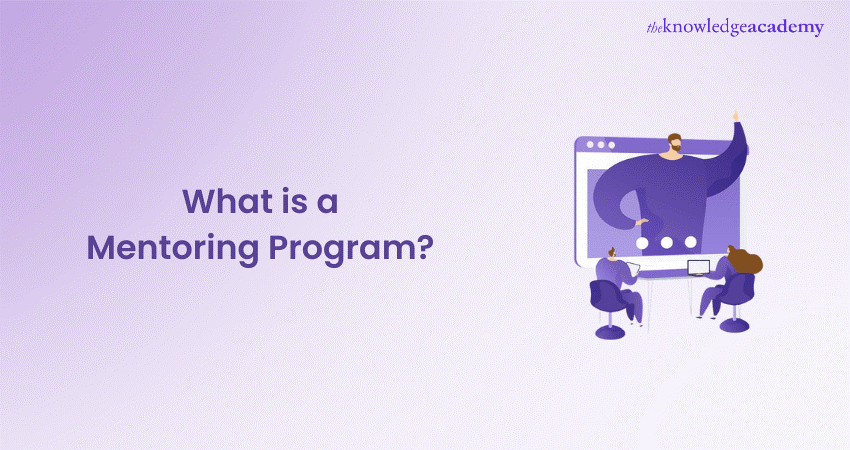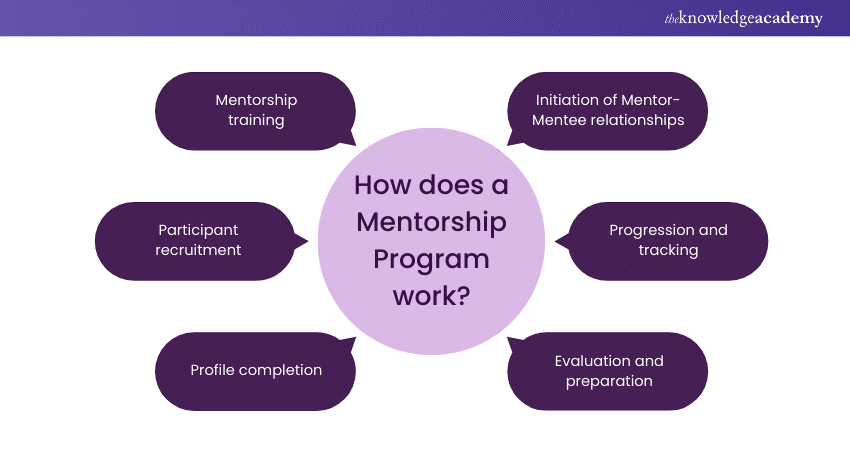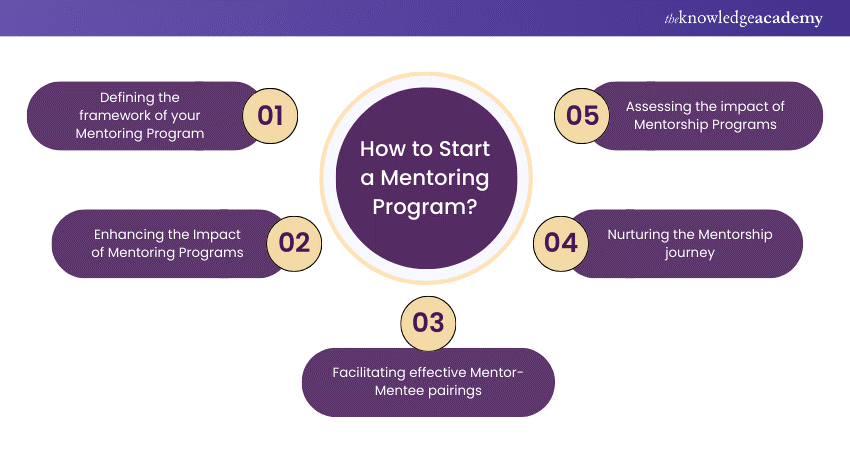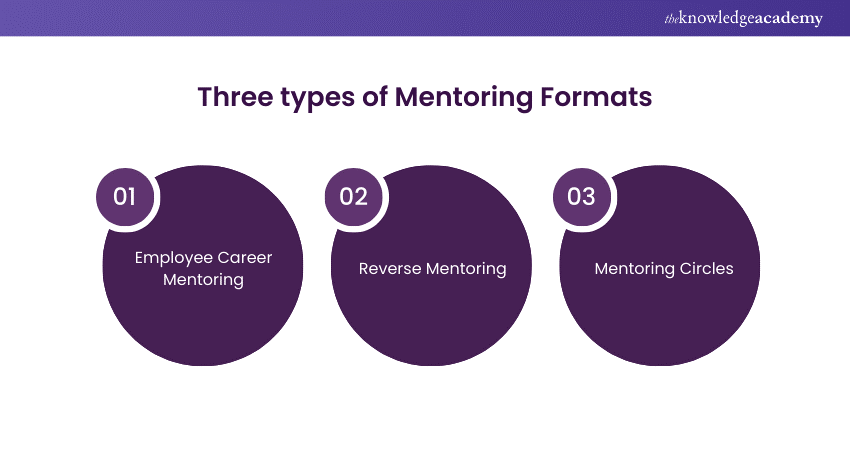We may not have the course you’re looking for. If you enquire or give us a call on +44 1344 203999 and speak to our training experts, we may still be able to help with your training requirements.
Training Outcomes Within Your Budget!
We ensure quality, budget-alignment, and timely delivery by our expert instructors.

When it comes to personal and professional growth, nothing compares to the power of a guiding hand. That’s where the Mentoring Program steps in, lighting the path ahead. But do you know What is a Mentoring Program?
These Programs serve as the scaffolding that supports individuals in their journey towards achieving their full potential. By pairing experienced Mentors with eager Mentees, these programs foster an environment ripe for growth, learning, and empowerment.
If you, too, want to empower your workforce, then you must learn about how these programs work and their benefits in the organisation. Read this blog to explore answer to the question: “What is a Mentoring Program?” Go on to shape careers and forge leaders of the future.
Table of Contents
1) Understanding What is a Mentoring Program?
2) How does a Mentorship Program work?
3) How to start a Mentoring Program?
4) Three types of Mentoring formats
5) Mentorship’s four pillars
6) Conclusion
Understanding What is a Mentoring Program?
Mentorship Programs are a strategic approach within organisations that pair seasoned professionals, or Mentors, with team members seeking to enhance their skills and experiences, known as Mentees. These programs are pivotal in fostering successful developmental relationships. Critical elements of a successful workplace Mentoring Program include:
a) Mentors: Experienced individuals who leverage past experiences to guide Mentees towards achieving their objectives.
b) Mentee: The learner in the relationship aims to grow and achieve specific goals with the Mentor’s support.
c) Mentoring Program Manager: The person in charge of the program is responsible for pairing participants and managing relationships. They set up training for Mentors and monitor the program’s effectiveness.
d) Mentoring goals: These goals are the specific skills, experiences, or knowledge the Mentee aspires to gain from the Mentoring relationship.
e) Mentor matching: This is the process that Program Managers use to align Mentors and Mentees based on personality traits and experiences, ensuring the most beneficial pairing.
f) Program cycle: The duration of the Mentoring relationship, which can vary but often follows 3-, 6-, or 12-month periods.
g) Formal Mentoring: It is a structured program in which Mentor-Mentee matches are made through an unbiased algorithm or manually by Program Managers, often with a set curriculum and goals.
h) Informal Mentoring: A more flexible approach where Mentees choose their Mentors, often in an Open Mentoring Program, and set their own goals.
i) Group Mentoring: A format where one Mentor supports multiple Mentees simultaneously.
j) 1-to-1 Mentoring: A direct Mentoring relationship between one Mentor and one Mentee.
k) Manual Mentoring: A Mentoring Program managed manually, often using tools like spreadsheet software.
l) Mentoring software: It is a specialised tool designed to streamline the management of Mentorship Programs. It enables organisations to expand their Mentoring initiatives and track results more efficiently.
Engaging with Mentoring Programs introduces a wealth of terminology, especially when implementing Mentoring software. It is highly recommended that administrative burdens be minimised and the return on investment in Mentoring Program Management be enhanced.
How does a Mentorship Program work?
Now that you know What is a Mentoring Program, it is equally crucial to understand how it works. Regardless of their specific format, Mentoring Programs typically adhere to a simple framework. Here’s a refined overview of the typical flow:

Mentorship training
Program administrators design the Mentoring initiative. They set criteria for Mentor qualifications, Mentee participation, and, if applicable, formal objectives for Mentees.
Participant recruitment
Invitations are extended to potential Mentors and Mentees to join the program.
Profile completion
Both Mentors and Mentees must fill out detailed profiles. In software programs, this step includes surveys and algorithmic matching to impartially pair participants, sidestepping biases inherent in manual processes.
Initiation of Mentor-Mentee relationships
Matches are made, and the paired individuals commence their Mentoring sessions.
Progression and tracking
Throughout the program, Mentors and Mentees monitor their advancement towards set goals while administrators collect data on the Mentoring dynamics.
Evaluation and preparation
At the end of the program cycle, administrators analyse the outcomes and start planning for the subsequent cycle. This simplified model encapsulates the essence of Mentoring Programs, which includes the following:
a) Recruit
b) Match
c) Engage
d) Assess
While programs can be tailored to an organisation’s needs, they fundamentally revolve around these core stages.
Elevate your coaching expertise with our Coaching Skills Training – sign up today!
How to start a Mentoring Program?
Here is a step by step guide on how to start a Mentoring Program:

Step 1: Defining the framework of your Mentoring Program
The inception of a Mentoring Program is anchored in two pivotal questions:
a) What is the impetus behind the initiation of your Mentoring Program?
b) How do you envision success for the participants and the organisation?
Addressing these questions necessitates a profound comprehension of your intended audience. It’s crucial to grasp their identity, location, developmental requirements, and primary incentives for engagement. Articulate your aspirations into SMART goals: Specific, Measurable, Achievable, Relevant, and Time-bound. The advantages of delineating Mentoring objectives are manifold, including the following:
a) Guiding participants
b) Formulating program KPIs
c) Justifying the program to organisational leaders
Picture this: A male and female colleague collaborating over a laptop in a café, brainstorming the architecture of a Mentoring Program. This imagery encapsulates the essence of successful Mentorship initiatives, which marry structure with adaptability.
Structure equips participants with a clear Mentoring journey that is pivotal for attaining meaningful learning that is aligned with set Mentorship objectives. Conversely, adaptability caters to the diverse Mentoring requisites of individuals, encompassing distinct learning ambitions, preferences, and styles. Critical design choices for your Mentoring Program encompass:
a) Register: Will it be universally accessible, application-based, or by invitation?
b) Mentoring style: Options include traditional, flash, or reverse Mentoring.
c) Connection type: Formats could be one-on-one, group Mentoring, or one-to-many.
d) Connection duration: Spanning from a few weeks to months or even a single session.
e) Measurement: Establish mechanisms for monitoring progress and outcomes.
Crafting a workflow diagram for your program is advisable, detailing each stage, associated actions, timelines, support mechanisms, and transition criteria. Highlight segments that necessitate adaptability to accommodate diverse needs.
Moreover, leveraging Mentoring software can streamline the delivery of various Mentoring schemes. Irrespective of the program’s scale, user-friendly Mentoring software facilitates a seamless launch and operation of your Mentorship initiatives.
Step 2: Enhancing the Impact of Mentoring Programs
For Mentoring Programs to thrive, they must be effectively promoted, and both Mentors and Mentees must be properly recruited and trained. Although introducing formal Mentorship initiatives often sparks initial excitement within organisations, this doesn’t necessarily lead to high engagement levels.
One frequent obstacle is the inadequate promotion of the program. It’s essential not to take for granted that potential Mentors and Mentees know the program’s benefits. Since Mentorship might be a novel experience for many, it’s important to illustrate the advantages and the commitment’s worthiness. It is also important to inform key leaders and stakeholders about the program’s strategic importance. To establish a robust Mentor base, consider the following:
a) How can you streamline the Mentoring process to respect the Mentors’ time commitments?
b) Implement formal recognition for Mentors to encourage participation and attract more Mentors.
Effective Mentoring requires more than just good intentions. It’s important to provide training for both Mentors and Mentees on:
a) Advocating the program’s benefits to all involved parties.
b) Considering incentives and acknowledgement of active participation in Mentoring.
c) Offering continuous Mentorship training and support throughout the program’s duration.
d) Defining the objectives of Mentorship Programs.
e) Outlining the roles of Mentoring participants.
f) Sharing Mentoring best practices.
g) Explaining the organisational Mentoring process.
h) Clarifying the goals for both Mentors and Mentees.
Mentoring training and support should extend beyond the initial orientation. Continually offer tips and best practices to ensure participants remain focused and derive maximum benefit from the program.
Step 3: Facilitating effective Mentor-Mentee pairings
Achieving a successful Mentor-Mentee relationship hinges on the quality of the match. It’s a complex task, as each participant brings unique skills, backgrounds, and learning preferences. A pairing that works well for one individual may not be suitable for another. The following are the three steps to effective Mentor-Mentee matching:
a) Develop detailed user profiles: Gather comprehensive data, including demographics, tenure, location, interests, and job functions.
b) Select a matching method: Choose between self-matching, where Mentees pick their Mentors, or admin-matching, where program administrators make the pairings.
c) Utilise intelligent matching: Apply Mentoring software to match based on detailed profiles, enhancing match quality and efficiency.
When matching Mentors and Mentees, aligning their goals with the program’s objectives is essential. Consider career goals, industry experience, and personal interests. Diversity, Equity, and Inclusion (DEI) should also inform your criteria, ensuring diverse and inclusive pairings. Software like Chronus can facilitate this process with customisable criteria that reflect participants’ preferences and DEI considerations. This helps increase the chances of successful matches.
You’ll need to decide on self-matching or admin-matching for your program. Self-matching allows Mentees to choose their Mentors, which can be more manageable administratively, especially in larger programs. Consider the Mentor’s style, including their communication approach, leadership style, and Mentoring philosophy, as these factors significantly affect the Mentor-Mentee dynamic.
For structured programs with large groups, such as new students or employees, admin matching might be preferable to kickstart the program. The software can assist in evaluating potential matches and ensuring quality Mentors for those harder to match.
Best Practices for Matching:
The matching process is critical to the success of a Mentorship Program. It involves:
a) Creating robust profiles: Include development goals and Mentoring objectives to guide the pairing process.
b) Aligning goals and interests: Ensure Mentors and Mentees have compatible objectives and interests for a productive relationship.
Remember, the best matching practices begin with comprehensive profiles for all participants, focusing on their development and Mentoring goals as well as their specific interests. This foundation facilitates the creation of matches conducive to growth, learning, and mutual support.
Enhance your knowledge of Mentorship skills and knowledge with our Mentoring Training – join us now!
Step 4: Nurturing the Mentorship journey
With participants registered, trained, and matched, the Mentorship journey truly begins. This phase is critical, as Mentorships can either flourish or flounder. Some Mentorships may struggle because Mentoring often falls outside of daily routines. Without clear direction and a structured plan, the Mentorship bond may wane in focus and drive.
Hence, infusing structure and ongoing guidance is essential for the prosperity of Mentoring Programs. A key practice in successful Mentoring Programs is establishing goals and action plans for all Mentorships. This approach serves a dual purpose:
a) It provides immediate focus, fostering a strong start to the Mentor-Mentee relationship.
b) It instils a sense of responsibility to achieve set objectives.
It’s important to equip all Mentoring pairs with “help resources” — such as topical content and best practices in Mentoring — at strategic points throughout their journey. Optimal are bite-sized resources that are easy to digest and timely.
Imagine a scenario where one employee Mentors another in an office kitchen, symbolising the forward momentum of the Mentorship. As the relationship develops, setting up milestones for Mentorships to report their progress is beneficial. Finally, a formal conclusion process should be in place, encompassing:
a) A moment for both Mentor and Mentee to reflect on their learnings.
b) A discussion about the Mentee’s future steps.
c) An evaluation of the program’s benefits and the overall process.
Step 5: Assessing the impact of Mentorship Programs
Launching a Mentorship initiative requires substantial resources, including management efforts, infrastructure, and the precious time of all involved. Demonstrating the Return on Investment (ROI) for Mentoring is vital to ensure continued financial and organisational support. Moreover, the evaluation phase aims to monitor the program's health, spotting challenges and growth areas.
Effective Mentorship Programs are monitored, evaluated, and reviewed at three levels: the overall program, the Mentor-Mentee interactions, and the individual experiences. For efficiency, it’s important to have mechanisms to gather data and feedback throughout the program’s duration.
To measure Mentoring effectively, consider these three dimensions: individual learning, overall program vitality, and the activity within Mentor-Mentee connections. At the program level, establish metrics that align with specific organisational goals.
For instance, in DEI (Diversity, Equity, and Inclusion) Mentorship initiatives, you might analyse the promotion rates of participants versus those not in the program. Additionally, monitor conversion metrics that track participant progress from registration through various stages of the program. These metrics are critical for gauging the program’s vitality.
When examining Mentor-Mentee connections, aim to understand the dynamics of these relationships to pinpoint potential obstacles and opportunities. Key questions to consider include:
a) Is the duration of the Mentorship appropriate?
b) Are Mentorships beginning effectively or experiencing delays?
c) Are participants utilising the provided resources effectively?
For individual participants, assess the impact of the Mentorship in terms of outcomes and gather feedback on the program. Surveys are a straightforward method to collect this information. Inquire about the program’s success in meeting its objectives and those of the organisation and solicit suggestions for program enhancements.
Step into the world of impactful guidance with our Coaching and Mentoring Skills Training – Sign up now!
Three types of Mentoring Formats
Mentoring comes in various forms, each fostering growth, development, and connectivity. Selecting the right Types of Mentoring format is crucial for aligning with your organisation’s culture and its members’ needs. Here are three Mentoring formats to consider:

Employee Career Mentoring
This is the most prevalent form of Mentoring in the workplace, offering structured career progression to demonstrate an organisation’s investment in its employees’ futures. Typically, this one-on-one Mentoring lasts nine to twelve months, providing employees with skill development opportunities that promote career advancement and prevent job stagnation.
Reverse Mentoring
In this innovative approach, a junior employee Mentors a senior colleague, often in a one-on-one or group setting. The junior Mentor shares fresh insights on industry trends, technological skills, and organisational culture, providing valuable perspectives to more experienced staff members.
Mentoring Circles
Mentoring circles operate on a peer-to-peer basis, resembling group Mentoring. They allow employees to connect with others who have similar interests or learning goals, fostering collective development. This format encourages interdepartmental and intergenerational learning, broadening the organisation’s knowledge base.
It also supports the formation of diverse cross-functional relationships. For ERGs, Mentoring circles offer a safe space for individuals with shared backgrounds to engage in open dialogue, support, and self-expression.
Conclusion
A Mentorship Program is a synergistic relationship that accelerates personal and professional growth. It’s a journey where wisdom and opportunities are shared, fostering an environment of support and encouragement. Understanding What is a Mentoring Program to recognise its transformative power—Mentees gain insights and guidance, while Mentors receive fresh perspectives and the satisfaction of giving back. This reciprocal exchange not only cultivates talent but also strengthens the community.
Unlock your training potential with our Train the Trainer Course – register now!
Frequently Asked Questions

Mentoring is vital for personal and professional development. It provides Mentees with the opportunity to learn from experienced individuals, gain new skills, build confidence, and make more informed decisions. Mentors also benefit by gaining satisfaction from helping others grow, enhancing their own Mentoring and leadership skills, and experiencing new ideas and perspectives.

Yes, having multiple Mentors can be quite beneficial. It allows you to have diverse perspectives and guidance tailored to different areas of your development. However, it’s important to have distinct goals for each Mentoring relationship to ensure that each one is focused and effective.

The Knowledge Academy offers various Train the Trainer, including Mentoring Training and Coaching Skills Training. These courses cater to different skill levels, providing comprehensive insights into Role of a Mentor.
Our Business Skills Blogs cover a range of topics related to Mentoring, offering valuable resources, best practices, and industry insights. Whether you are a beginner or looking to advance your Coaching skills, The Knowledge Academy's diverse courses and informative blogs have you covered.

The Knowledge Academy’s Knowledge Pass, a prepaid voucher, adds another layer of flexibility, allowing course bookings over a 12-month period. Join us on a journey where education knows no bounds.

The Knowledge Academy takes global learning to new heights, offering over 30,000 online courses across 490+ locations in 220 countries. This expansive reach ensures accessibility and convenience for learners worldwide.
Alongside our diverse Online Course Catalogue, encompassing 17 major categories, we go the extra mile by providing a plethora of free educational Online Resources like News updates, Blogs, videos, webinars, and interview questions. Tailoring learning experiences further, professionals can maximise value with customisable Course Bundles of TKA.
Upcoming Business Skills Resources Batches & Dates
Date
 Train the Trainer
Train the Trainer
Fri 28th Jun 2024
Fri 30th Aug 2024
Fri 25th Oct 2024
Fri 27th Dec 2024









 Top Rated Course
Top Rated Course



 If you wish to make any changes to your course, please
If you wish to make any changes to your course, please


